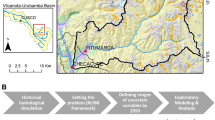Abstract
Studies of water resources carrying capacity (WRCC) can provide helpful information about how the socio-economic system is both supported and restrained by the water resources system. As such, there is a need to develop better quantitative assessment methods to determine the potential maximum socio-economic growth within a catchment subjected to a given amount of water resource. An improved WRCC assessment method based on a system dynamics model (WRCC-SDM) is proposed in this paper. WRCC-SDM is built on synthesis simulations of coupling effects and feedback mechanisms within the society-economy-water compound system. The results can integrally represent system behaviors and states, and the evaluation of WRCC is achieved using this model. Moreover, an integrated indicator (Population-GDP-GDP per capita) is proposed to express the threshold value of WRCC. Based on the natural water resources supply capacity and associated socio-economic development potential, the concepts of critical WRCC and extreme WRCC are put forward. Critical WRCC represents the socio-economic scale that will cause total water demand to reach the maximum natural water resources supply capacity, while extreme WRCC reflects the socio-economic scale when the GDP growth rate constrained by limited water resources is zero. The methodology was applied to assess the water resources situation in Tieling City, China under different scenarios. The results indicate that: (1) Given the constraints represented by water resources, projected GDP growth tends to follow an S-curve growth pattern; and (2) Rapid population growth may lead to earlier and more severe water resources constraints.






Similar content being viewed by others
References
Arnell NW (1999) Climate change and global water resources. Global Environ Chang 9:S31–S49
Chen ZH, Wei S (2013) Application of system dynamics to water security research. Water Resour Manag 28(2):287–300
Chow GC, Li KW (2002) China’s economic growth: 1952–2010. Econ Dev Cult Chang 51(1):247–256
Feng LH, Zhang XC, Luo GY (2008) Application of system dynamics in analyzing the carrying capacity of water resources in Yiwu City, China. Math Comput Simul 79(3):269–278
Gastélum JR, Valdés JB, Stewart S (2009) A decision support system to improve water resources management in the Conchos Basin. Water Resour Manag 23(8):1519–1548
Gong L, Jin CL (2009) Fuzzy comprehensive evaluation for carrying capacity of regional water resources. Water Resour Manag 23(12):2505–2513
Han M, Liu Y, Du Y, Yang XY (2010) Advances in study on water resources carrying capacity in China. Procedia Environ Sci 2:1894–1903
Holz CA (2008) China’s economic growth 1978–2025: what we know today about China’s economic growth tomorrow. World Dev 36(10):1665–1691
Huang YF, Ren RE, Liu XS (2002) Capital stock estimates in Chinese manufacturing by perpetual inventory approach. China Econ Q 1(2):377–396
Huang Q, Zhang ZZ, Wang K, Li Q, Qi QQ (2008) Improvement to the dilution-ratio calculation method and its application. J Saf Environ 8(1):37–39
Mirchi A, Madani K, Watkins D Jr, Ahmad S (2012) Synthesis of system dynamics tools for holistic conceptualization of water resources problems. Water Resour Manag 26(9):2421–2442
Qin HP, Su Q, Khu ST (2011) An integrated model for water management in a rapidly urbanizing catchment. Environ Model Softw 26(12):1502–1514
Song XM, Kong FZ, Zhan CS (2011) Assessment of water resources carrying capacity in Tianjin City of China. Water Resour Manag 25(3):857–873
Tieling Municipal Bureau of Statistics (2011) Tieling statistical yearbook. Tieling. (in Chinese)
Tieling Municipal Bureau of Water Resources (2011) Water resources bulletin of Tieling. Tieling. (in Chinese)
Wang S, Yang FL, Xu L, Du J (2013) Multi-scale analysis of the water resources carrying capacity of the Liaohe Basin based on ecological footprints. J Clean Prod 53:158–166
Wei SK, Yang H, Song JX, Abbaspour KC, Xu ZX (2012) System dynamics simulation model for assessing socio-economic impacts of different levels of environmental flow allocation in the Weihe River Basin, China. Eur J Oper Res 221(1):248–262
Winz I, Brierley G, Trowsdale S (2009) The use of system dynamics simulation in water resources management. Water Resour Manag 23(7):1301–1323
Xu ZX, Takeuchi K, Ishidaira H, Zhang XW (2002) Sustainability analysis for Yellow River water resources using the system dynamics approach. Water Resour Manag 16(3):239–261
Acknowledgments
This work was financially supported by the Chinese National Specialised Projects for the Control and Treatment Technology of Water Pollution (Project number: 2013ZX07501-005).
Author information
Authors and Affiliations
Corresponding author
Rights and permissions
About this article
Cite this article
Yang, J., Lei, K., Khu, S. et al. Assessment of Water Resources Carrying Capacity for Sustainable Development Based on a System Dynamics Model: A Case Study of Tieling City, China. Water Resour Manage 29, 885–899 (2015). https://doi.org/10.1007/s11269-014-0849-y
Received:
Accepted:
Published:
Issue Date:
DOI: https://doi.org/10.1007/s11269-014-0849-y




